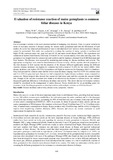Evaluation of resistance reaction of maize germplasm to common foliar diseases in Kenya

View/
Date
2015Author
Muiru, WM
Charles, A K
Kimenju, JW
Njoroge, K
Miano, DW
Language
enMetadata
Show full item recordAbstract
Use of resistance varieties is the most practical method of managing crop diseases. There is a great variation in
terms of resistance reaction to diseases among the various maize germplasm and with the liberization of seed
market, the sector has witnessed proliferation of massive introduction of new varieties whose reaction to diseases
cannot be ascertained. This study was conducted to evaluate the reaction of maize varieties to northern leaf
blight (NLB), common maize rust, gray leaf spot (GLS) and maize streak disease (MSD). The experiment was
conducted at Kabete Field Station, University of Nairobi for two seasons namely short rains and long rains. The
germplasm was bought from the commercial seed stockists and the landraces obtained from KARI Katumani and
from farmers. The diseases were assessed by monitoring and scoring for disease incidence and severity. The
appropriate scoring keys were used for determination of disease severity. All the varieties showed symptoms of
the four diseases in both seasons but the intensity of the diseases differed significantly among the different
varieties. Disease incidence was highest for common rust with a mean of 14.29% for the variety DH04, while
disease incidence was highest (19.21%) for northern leaf blight in season two for Kinyanya which is a landrace.
Gray leaf spot and the common smuts had the lowest mean incidence ranging from 0 to 0.25% for common smut
and 0 to 2.6% for gray leaf spot. Season two had comparatively higher disease incidence means compared to
season one. Meteorological data showed that season two had more rains and this explains the reasons behind
this. Though all the varieties screened were found to be affected by the diseases to various levels, the varieties
displayed significant differences in the disease incidence and severity. This shows that use of resistance varieties
should be considered in the management of maize diseases. Focus should also be on pyramiding genes for
resistance in the breeding programmes to develop varieties with multiple resistance to different diseases.
Citation
Muiru, W. M., Charles, A. K., Kimenju, J. W., Njoroge, K., & Miano, D. W. (2015). Evaluation of resistance reaction of maize germplasm to common foliar diseases in Kenya. Journal of Natural Sciences Research, 5(1), 140-145.Publisher
University of Nairobi
